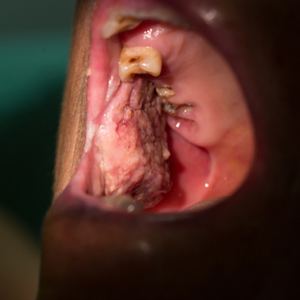
What is squamous cell carcinoma of the oral cavity?
Squamous cell carcinoma of the oral cavity is a tumour that can in principle occur anywhere in the oral cavity, but usually originates from the uppermost cell layer of the oral mucosa. squamous cell carcinoma of the oral cavity accounts for 5.6 percent of all malignant tumours. This puts it in sixth place among all tumour diseases, and men are statistically more likely to develop the disease.
What are the risk factors for the development of squamous cell carcinoma of the oral cavity?
The triggering factors for squamous cell carcinoma of the oral cavity are the consumption of tobacco and alcohol. The probability of developing squamous cell carcinoma of the oral cavity increases depending on the amount and duration of nicotine consumption. A person who smokes a lot has seven times the risk of developing oral cavity carcinoma compared to a non-smoker. This risk is due to the carcinogenic ingredients of tobacco. Nitrosamines and aromatic hydrocarbons are the most dangerous substances. People who regularly consume alcohol as well as tobacco products increase their risk of developing squamous cell carcinoma of the oral cavity, because alcohol lowers the permeability of the oral mucosa for the carcinogenic ingredients of tobacco. In this way, the harmful substances can penetrate deep into the tissue layers. Studies have shown that the combined consumption of alcohol and nicotine increases the risk of cancer up to 40-fold compared to people who neither drink nor smoke.
In addition to these risk factors, human papilloma viruses (HPV) also play an important role in the development of squamous cell carcinoma of the oral cavity. For about 10 percent of all oral cavity carcinomas, a connection with an HPV infection could be proven. But poor oral hygiene and chronic irritation of the oral mucosa are certainly further risk factors. In rare cases, however, it also happens that the cancer develops for no apparent reason.
What symptoms does squamous cell carcinoma of the oral cavity produce?
If external changes in the oral mucosa are noticed that persist for more than 14 days, medical advice should definitely be sought. Oral cavity carcinoma can usually appear in many different ways. In addition to a whitish or reddish change in the oral mucosa that appears harmless but cannot be wiped off, there may also be open sores (ulcerations) or tumours (tissue growths). Especially in the early stages, these external changes do not cause any pain.
How is squamous cell carcinoma of the oral cavity diagnosed?
Squamous cell carcinoma of the oral cavity is usually diagnosed at an advanced stage of cancer, when the patient already experiences symptoms. Only about one in ten tumours is detected within a general examination or screening. This is because tumours that are up to 1 cm in diameter usually remain asymptomatic. Only larger tumours cause pain, but they can also cause swelling or infections (ulcerations).
If squamous cell carcinoma of the oral cavity is suspected, the doctor will first examine the oral mucosa for changes. In addition to this clinical assessment, various examination procedures are used to better assess the degree of risk of oral mucosal changes. These include, for example, the VELscope procedure (Vision Enhanced Lesion Scope), which makes the tissue structure visible with regard to its changeability. In addition, the so-called brush biopsy can be used, with the help of which material is obtained to determine cancer markers.
If the change in the oral mucosa persists for more than two weeks despite treatment, the diagnosis is considered confirmed. Imaging procedures such as computer tomography (CT) or magnetic resonance imaging (MRI) are then used to determine the extent of the tumour in order to develop a suitable therapy.
How is squamous cell carcinoma of the oral cavity treated?
The choice of therapy depends not only on the patient's age and general state of health, but also on the stage of the cancer and the size of the tumour. If it is a small localised tumour between stage I and II, it can be successfully treated by local excision in 80 to 90 percent of all cases. In the case of a tumour from stage III onwards, surgical intervention (resection) or radiation alone is usually not sufficient. In this case, a multimodal treatment is necessary for successful tumour treatment, which consists of a surgical intervention combined with radiation and chemotherapy. This combined therapy is advisable because squamous cell carcinoma of the oral cavity is usually no longer localised at this stage, but in 38 percent of all cases has already formed distant metastases, which mainly affect the lungs.
What are the prognosis prospects for squamous cell carcinoma of the oral cavity?
Thanks to modern medicine, squamous cell carcinoma of the oral cavity can now be diagnosed more easily at an early stage of the cancer. This is crucial in order to take immediate therapeutic measures. Because the chances of cure depend to a decisive degree on immediate treatment. However, the complete cure prospects of patients with advanced squamous cell carcinoma of the oral cavity remain poor. The 5-year survival rate for these patients is between 45 and 53 per cent. However, it also depends on whether the squamous cell carcinoma of the oral cavity has already formed lymph node metastases. Since the lymph nodes serve as so-called filter stations in the body and are responsible for the defence against disease, they play a decisive role in regeneration.
